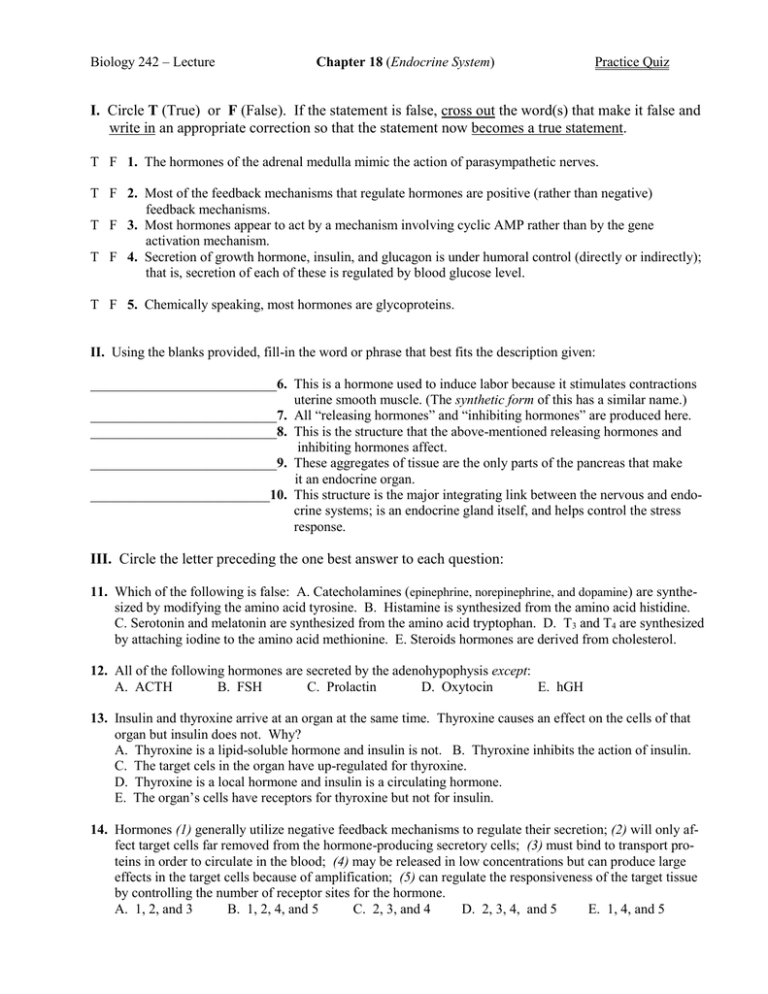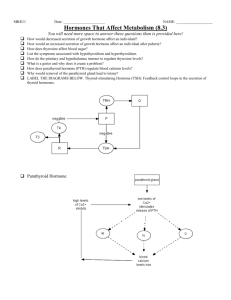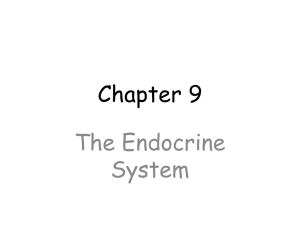I. write in an appropriate correction so that the statement now...
advertisement

Biology 242 – Lecture Chapter 18 (Endocrine System) Practice Quiz I. Circle T (True) or F (False). If the statement is false, cross out the word(s) that make it false and write in an appropriate correction so that the statement now becomes a true statement. T F 1. The hormones of the adrenal medulla mimic the action of parasympathetic nerves. T F 2. Most of the feedback mechanisms that regulate hormones are positive (rather than negative) feedback mechanisms. T F 3. Most hormones appear to act by a mechanism involving cyclic AMP rather than by the gene activation mechanism. T F 4. Secretion of growth hormone, insulin, and glucagon is under humoral control (directly or indirectly); that is, secretion of each of these is regulated by blood glucose level. T F 5. Chemically speaking, most hormones are glycoproteins. II. Using the blanks provided, fill-in the word or phrase that best fits the description given: ___________________________6. This is a hormone used to induce labor because it stimulates contractions uterine smooth muscle. (The synthetic form of this has a similar name.) ___________________________7. All “releasing hormones” and “inhibiting hormones” are produced here. ___________________________8. This is the structure that the above-mentioned releasing hormones and inhibiting hormones affect. ___________________________9. These aggregates of tissue are the only parts of the pancreas that make it an endocrine organ. __________________________10. This structure is the major integrating link between the nervous and endocrine systems; is an endocrine gland itself, and helps control the stress response. III. Circle the letter preceding the one best answer to each question: 11. Which of the following is false: A. Catecholamines (epinephrine, norepinephrine, and dopamine) are synthesized by modifying the amino acid tyrosine. B. Histamine is synthesized from the amino acid histidine. C. Serotonin and melatonin are synthesized from the amino acid tryptophan. D. T3 and T4 are synthesized by attaching iodine to the amino acid methionine. E. Steroids hormones are derived from cholesterol. 12. All of the following hormones are secreted by the adenohypophysis except: A. ACTH B. FSH C. Prolactin D. Oxytocin E. hGH 13. Insulin and thyroxine arrive at an organ at the same time. Thyroxine causes an effect on the cells of that organ but insulin does not. Why? A. Thyroxine is a lipid-soluble hormone and insulin is not. B. Thyroxine inhibits the action of insulin. C. The target cels in the organ have up-regulated for thyroxine. D. Thyroxine is a local hormone and insulin is a circulating hormone. E. The organ’s cells have receptors for thyroxine but not for insulin. 14. Hormones (1) generally utilize negative feedback mechanisms to regulate their secretion; (2) will only affect target cells far removed from the hormone-producing secretory cells; (3) must bind to transport proteins in order to circulate in the blood; (4) may be released in low concentrations but can produce large effects in the target cells because of amplification; (5) can regulate the responsiveness of the target tissue by controlling the number of receptor sites for the hormone. A. 1, 2, and 3 B. 1, 2, 4, and 5 C. 2, 3, and 4 D. 2, 3, 4, and 5 E. 1, 4, and 5




